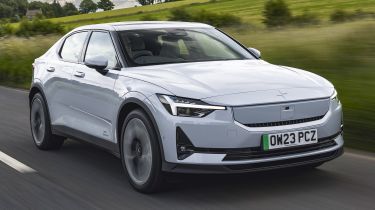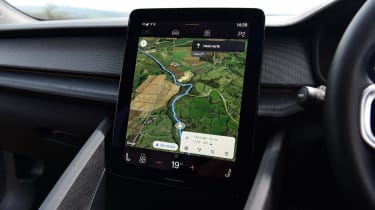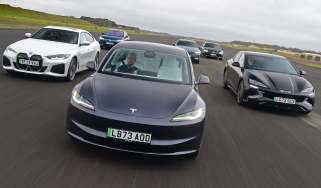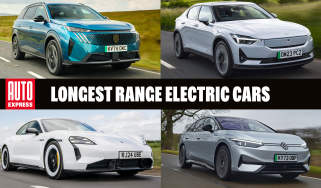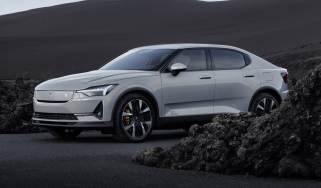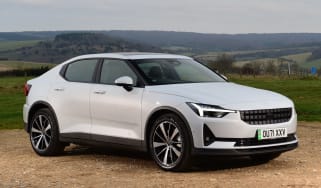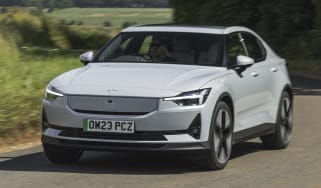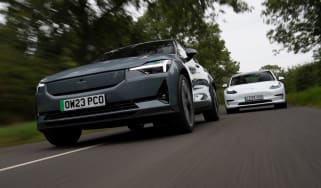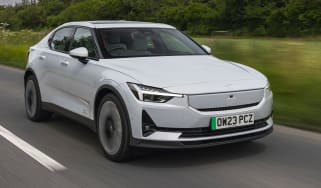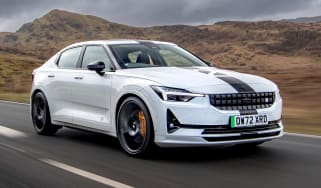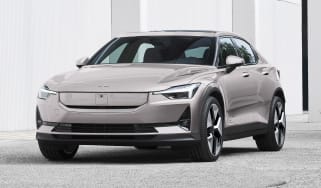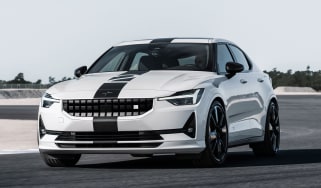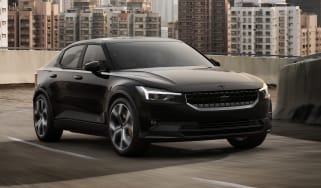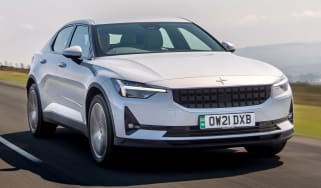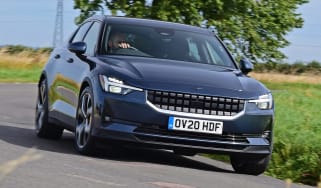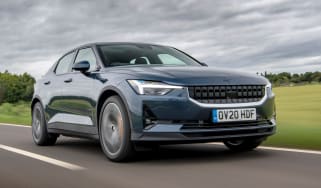Polestar 2 review
The stylish Polestar 2 oozes quality and has a long electric range, but an overly firm ride holds it back

Quick review
The Polestar 2 continues to deliver quality, style, great onboard tech, and reassuring levels of safety kit. The updated model gets more power and an official range of over 400 miles that few electric cars can even come close to matching – including some that cost twice as much.
For those seeking something different from a Tesla Model 3 in the compact, premium EV space, the Polestar 2 has most bases covered, and it’s competitively priced, too. Its main downside is that the ride is too firm for most UK roads, and it doesn’t drive as sharply as the BMW i4 to make that a worthwhile compromise.
Polestar 2: price, specs and rivals
It wasn’t that long ago that Polestar held the banner for Volvo’s motorsport activity (mainly in Swedish touring cars) before becoming the performance sub-brand for the Swedish marque’s quicker models. Now, under joint ownership of Volvo and Chinese giant Geely, Polestar has become a maker of premium electric cars and has a range of highly anticipated electric cars in the works, including the flagship Polestar 5 GT car and the Polestar 6 two-seat roadster.
But Polestar’s first foray into full vehicle production was in 2017 with the aptly named Polestar 1 – a low-volume, plug-in hybrid coupe. The fastback-styled Polestar 2 was the follow-up, an altogether more accessible car that the fledgling brand hoped would steal sales away from Tesla by offering a more stylish alternative to the hugely popular Tesla Model 3 saloon. Since the Polestar 2 launched in 2020, more players have entered the game, namely the excellent-to-drive BMW i4 and retro-futuristic Hyundai Ioniq 6, while the Volkswagen ID.7 offers long-range comfort and lots of practicality.
Used - available now
The Polestar 2 sits on Volvo’s Compact Modular Architecture (CMA) platform, which the Volvo XC40 SUV and Volvo C40 coupe-SUV also use. It has a saloon-like body but is actually a five-door hatchback with a slightly elevated ride height. This gives it a unique shape that’s not quite a crossover but still offers decent family practicality.
The Polestar 2 received a raft of updates in early 2023, including the addition of the ‘SmartZone’ grille panel that was first seen on the Polestar 3 large SUV, and includes various sensors, radar, cameras, and laser scanners for the autonomous safety systems. Other changes include switching the Single-Motoror versions from front to rear-wheel drive, making the electric motors more powerful and efficient, plus fitting larger batteries to Long-Range models.
There are three versions of the Polestar 2 to choose from, starting with the entry-level Standard Range Single Motor. This model is priced at just under £45,000, features a 69kWh battery and is good for a range of up to 339 miles. Long Range Single Motor cars get slightly more power, a bigger 82kWh battery and a maximum range of 406 miles – pretty impressive considering it costs less than £50,000. Long Range Dual Motor versions add an extra motor on the front axle for all-wheel drive, which bumps the power output to 416bhp and 740Nm of torque, but cuts the range to 368 miles.
There are no trim levels for the Polestar 2, just three additional packs that build on the already generous standard equipment list. That list includes an 11.2-inch touchscreen running Google-powered infotainment software, a 12.3-inch digital driver’s display, Apple CarPlay, a wireless charging pad, over-the-air (OTA) update capability, a 360-degree parking camera, and an extensive suite of safety systems.
The Pilot pack includes extra autonomous safety kit and Pixel LED headlights. The Plus pack includes a heat pump, Harman Kardon audio system, heated steering wheel, and fixed panoramic sunroof. You can also upgrade from the standard vegan-friendly upholstery to Zinc Nappa leather.
Only Dual Motor cars can be ordered with the Performance Pack, which boosts power to 469bhp and adds Brembo brakes, adjustable Ohlins dampers and 20-inch forged alloy wheels. You also get gold-coloured seat belts to match the brake calipers.
Electric motor, drive and performance
The Polestar 2 updates included efficiency boosts, extra range, and power. The Single-Motor variant switched from front to rear-wheel drive, while Dual-Motor, four-wheel models have a greater rear bias.
Polestar claims the changes have made the 2 “even more fun to drive”, and while that might be true when compared with its predecessor, the car is still no match for the BMW i4. The Polestar 2 isn’t bad in isolation, but body lean is more pronounced than in the BMW, and the Polestar 2 pitches and dives under heavy acceleration and braking, making it feel less agile than its rival. The steering isn’t as responsive as the best setups in this class, either.
Since its launch, the biggest issue we’ve had with the Polestar 2 is that the ride feels too firm for most UK roads, and this still hasn’t been addressed. When you encounter any kind of broken road surface, the car will start to bounce about, causing it to fidget constantly and become rather uncomfortable. It’s even worse in the back, which is bad news for those with children prone to motion sickness. Ride comfort is no better around town, where we found the unforgiving damping causes the car to jump about quite a bit at low speeds. If ride comfort is your priority, then look at the far more compliant Volkswagen ID.7 – especially one with adaptive suspension.
Refinement could also use some work because the Polestar 2 generated the most wind and road noise when tested against the Tesla Model 3 and its closest rivals.
We’d also like to see more variability with the regenerative braking, because you only get two settings in the Polestar 2, and you’ve got to delve into the touchscreen in order to change them. The Hyundai Ioniq 6 is far better in this regard, with easily accessible paddles behind the steering wheel giving you various settings from one-pedal driving in its strongest mode, to coasting while on a motorway cruise. The brake pedal feel for the mechanical brakes in the Polestar 2 is very firm at the top of the pedal travel, but we prefer the more progressive feel to the brakes in the i4 and Ioniq 6.
0-62mph acceleration and top speed
The Standard Range Single Motor Polestar 2 produces 268bhp and 490Nm of torque; enough to go from 0-62mph in 6.2 seconds and hit a top speed of 127mph (the same as all Polestar 2s). The Long Range Single Motor only gets a slight power bump up to 295bhp, though torque stays the same. It takes 5.9 seconds to complete the same benchmark sprint.
Even in Single Motor guise, the updated Polestar 2 is quick, thanks to instant throttle response and plenty of power for effortless overtaking.
Upgrading to the Long Range Dual Motor variant adds an extra motor on the front axle for all-wheel drive, yielding a total power output of 416bhp with 740Nm of torque. If that’s not enough get-up-and-go for you, you’ll need to add the Performance Pack. Available exclusively for the Dual Motor variant, this bumps the power up to 469bhp and cuts the range-topping Polestar 2’s 0-62mph time down from 4.3 to 4.0 seconds.
Range, charging and running costs
The revised Polestar 2 now consumes up to nine per cent less energy, can travel up to 22 per cent further, and charges up to 34 per cent faster following a number of updates introduced in 2023. The headline-grabbing figure is the Long Range Single Motor model’s official WLTP range of up to 406 miles – an increase from the pre-facelift version’s 341 miles of range.
The range kicks off with the Standard Range Single Motor model, which can cover up to 339 miles before its 69kWh battery (67kWh useable) runs flat. Long Range models get a larger 82kWh battery (79kWh useable) for the headline range figure of 406 miles in single-motor guise, or 368 miles if you spring for the Dual Motor version – the latter can disconnect its front motor while cruising to help with efficiency. Adding the Performance Pack to the Dual Motor version drops the maximum further to 352 miles.
The Polestar 2 hasn’t proven to be the most efficient EV in our own testing, especially compared to its rivals Tesla and BMW, making its official range figures more difficult to achieve in the real world. Polestar’s updates have helped a little, because the refreshed Long Range Single Motor variant we drove as part of our company car group test indicated a range of 271 miles on a full charge and was the fourth most efficient with 3.3 miles per kilowatt hour. That’s some way off 406 miles stated in the official tests, but still pretty impressive.
It’ll take a typical 7kW home wallbox roughly 10 hours to fully recharge the 69kWh battery in Standard Range Polestar 2s, and roughly 12 hours to do the same for Long Range versions with their 82kWh batteries.
The Polestar 2’s rapid charging capabilities aren’t the quickest compared with the Hyundai Ioniq 6, but base models will reach 135kW, meaning a 10 to 80 per cent top-up takes just 34 minutes. Meanwhile the rest of the range maxes out at 205kW, with the same charging session taking just 28 minutes if you find a suitably fast ultra-rapid charger.
The Polestar 2 costs more than the Tesla Model 3, but the Polestar 2’s starting price is lower than that of the BMW i4 and Ioniq 6, at least. Plus, it’s exempt from the London Congestion Charge and road tax (VED) until 2025 and will appeal to company car drivers thanks to its incredibly low Benefit-in-Kind (BiK) tax rating.
Insurance groups
Insurance ratings for the Polestar 2 vary depending on the battery and motor combo you opt for. The entry-level Standard Range Single Motor is in insurance group 40, while the Long Range Single Motor falls into group 41. The more powerful Polestar 2 Long Range Dual Motor lands in group 44, and the same goes for models equipped with the Performance Pack, which adds even more power.
The Polestar 2 won’t be the cheapest car to insure. In fact, the pricier BMW i4 will be less costly to cover because it attracts lower insurance ratings. The Tesla Model 3 will incur higher premiums because it occupies groups 48-50. The Tesla was judged by industry testers, Thatcham Research, to only offer ‘basic’ levels of protection for vehicle security, and so incurs higher insurance costs.
Check if your car needs an MoT and view its complete history with our MoT History Checker...
Depreciation
Data suggests the Polestar 2 after a three-year/36,000-mile period of ownership holds onto 41 to 49 per cent of its original value, with the Long Range Dual Motor versions delivering the strongest residuals.
In comparison, the Tesla Model 3 is expected to retain between 52 to 56 per cent, with the BMW i4 keeping between 50 and 55 per cent after the same 36 months of ownership.
To get an accurate valuation on a specific model check out our free car valuation tool...
Interior, design and technology
The Polestar 2 is a fastback-styled family car with a cool, minimalist design. Polestar��s close ties with Volvo are obvious even from a distance, as you quickly spot Volvo’s signature “Thor’s hammer” headlight design. The updated model also gets a body-coloured grille panel called the ‘SmartZone’, which houses various radars and cameras, and looks very similar to those on the facelifted Volvo XC40 Recharge and C40 Recharge,
The electric fastback has a classy, Volvo-like feel to the interior too, while the frameless door mirrors and glass roof panel just add to the stylish look. The smart steering wheel, chunky door handles and excellent seats are all very Volvo, but we’re certainly not complaining.
Leather upholstery isn’t included as standard with the 2, instead Polestar offers a ‘vegan interior’ with no animal products used in the cabin. However, if you really want to have some cowhide in the cabin, then light grey ‘Zinc’ Nappa leather upholstery is available as a £4,000 optional extra.
Buyers can select from different upholstery/interior trim combinations and add either the Pilot, Plus or Performance (only available on Dual Motor models) packs at extra cost. The respective packs bring lots of extra kit, relating to safety, additional luxury items or equipment to improve the driving experience. However, one downside to this method is that you can’t personalise your car by selecting individual options from those packs.
Sat-nav, stereo and infotainment
The Polestar 2’s 11.2-inch central touchscreen and 12.3-inch digital driver’s display offer crystal-clear graphics and plenty of functionality. Polestar wisely let Google handle the infotainment system and user interface in the Polestar 2. As a result, the system loads quickly, brings up postcode searches or other specific points of interest with ease, and can adapt a chosen route to real-time traffic changes.
The home screen is split into four quarters, showing Google Maps, Google Search, phone and media controls. Access to functions such as drive settings and external cameras can be accessed through shortcuts at the top, while climate controls can be adjusted at the bottom. Polestar is keen to point out that the infotainment system is being continually improved with over-the-air (OTA) updates.
The integration of Google Maps and other apps is among the best we’ve experienced, although you now have Apple CarPlay should you wish to use other apps on your iPhone. CarPlay requires a wired connection, but wireless phone charging is standard-fit.
Overall, most things work smoothly and easily. However, the central display in the Polestar 2 is small compared with the screens used by some rivals, such as Tesla. The more compact screen means some keys are smaller than they would be on the larger displays seen in the BMW i4 and Model 3, which makes the Polestar a little fiddlier to use. At least the portrait-oriented screen sits slightly proud of the dashboard, so it’s within easy reach.
Practicality, comfort and boot space
The Polestar 2's interior quality is high, and the seats are comfortable enough to ensure you arrive relaxed at the end of a long journey.
Unlike the Tesla Model 3 or Hyundai Ioniq 6, the Polestar 2 uses a platform that has to accommodate both combustion-engined models and those with battery-electric powertrains. One consequence of this CMA architecture shared with the Volvo XC40 is the huge transmission tunnel, which compromises comfort for anyone sitting in the middle seat. Those up front may find their knees knocking against the high-set centre console.
During our group test between the Polestar 2, BMW i4 and Tesla Model 3 we found the Polestar’s interior storage to be the least impressive of the three. The door bins are shallow and the central cubby is quite small, while you’ll find two cup-holders under the centre armrest.
Dimensions and size
The Polestar 2 measures 4,606mm in length, 1,859mm wide (excluding side mirrors) and stands 1,479mm tall. By comparison, the Tesla Model 3 is pretty much the same length, although not quite as wide and sits around 30mm lower. The Hyundai Ioniq 6 is even longer though, measuring 4,855mm from nose to tail, and stands 1,495mm tall and 1,880mm wide.
Leg room, head room & passenger space
There's a good amount of space inside the Polestar 2. Even though you feel more cocooned in the Polestar’s cockpit compared to other family EVs, those up front get plenty of head, leg and elbow room
Rear passenger space is a close match for the BMW i4, with a good amount of legroom on offer, plus foot space under the front seats. You get a set of air vents and two USB-C charging ports in the back, so your kids won’t have to squabble over who can charge their device on longer journeys. The optional glass roof does eat into headroom a touch, but even the tallest of occupants shouldn’t find it too intrusive. As we mentioned above, the large transmission tunnel doesn’t leave much space for anyone forced to take the middle seat.
There are three seats of ISOFIX mounting points in the Polestar hidden behind plastic covers. One is on the front passenger seat, while the other two are on the outer positions of the rear seats. During our testing, we noted that the rear door openings are smaller than we’d expect due in part to the sloping angle of the roof line, which doesn’t help when it comes to fitting a child seat.
Boot space
The Polestar 2's boot space is a decent 405 litres, which extends to 1,095 litres with the rear seats folded. It has an advantage over the Tesla Model 3 and Hyundai Ioniq 6 in that it has a hatchback tailgate that opens up much wider than its American and Korean rivals, making it easier to load luggage. There is also an extra 41 litres of stowage in the car’s nose or ‘frunk’, although it’s only big enough to store the charging cables.
Towing
Every version of the Polestar 2 has a maximum towing capacity of 1,500kg, or 750kg if it’s an unbraked trailer. Polestar also offers a semi-electric retractable towbar as an optional extra. You will need to look into what towing mirror extensions you can get for the Polestar 2, because its frameless mirrors can’t accept the type that clamp onto the door mirror casing.
Reliability and safety
The Polestar 2 shares its platform and running gear with the electric Volvo XC40 Recharge and C40 Recharge, so we don’t expect reliability to be too much of an issue.
Even in the short time they’ve been around, it appears the Polestar 2 and the Polestar brand as a whole have made quite the impression on UK buyers, based on the results of the 2023 Driver Power owner satisfaction survey. The Polestar 2 managed to finish 17th on our best cars to own list based on owners’ feedback – ahead of the Tesla Model 3 in 22nd place. Meanwhile, Polestar made its debut on the best car manufacturer rankings in second place – ahead of Tesla in third, and only behind Porsche. Owners liked their cars' performance and running costs, but they weren’t so keen on the ride, which is a major issue we have with the Polestar 2.
Industry experts Euro NCAP released its crash-test results for the Polestar 2 in March 2021, and it performed very well. The electric fastback was awarded the organisation’s maximum five-star overall rating, scoring 92 and 89 per cent for adult occupant protection and child protection, respectively. That rating still applies despite the change from front to rear-wheel drive for Single Motor variants.
The 2 also received an 86 per cent score in the safety assistance category, and comes with a full suite of safety systems as standard. Every Polestar 2 comes with a collision mitigation system, which uses front and rear-facing radars to take 'preventative measures' such as applying the brakes if a crash is likely to occur and the driver doesn’t react quickly enough. Other standard kit includes driver-awareness systems like blind-spot information with steering support, rear collision warning and mitigation, and a 360-degree parking camera.
More features are available as part of the optional Pilot Pack, which includes 'Pilot Assist' lane-keeping assistance, Pixel LED headlights, LED front fog lights with cornering function and adaptive cruise control.
Warranty
Polestar offers a three-year/60,000-mile warranty for the 2, while Tesla provides a four-year/50,000-mile warranty for the Model 3. The Hyundai Ioniq 6 has no mileage limits on its five years of coverage.
Like most electric cars, the Polestar’s battery is covered by a separate eight-year/100,000-mile warranty.
Servicing
The Polestar 2 needs servicing every two years or 18,600 miles, whichever comes soonest. Servicing can be carried out at a Volvo dealer because Polestar has ‘close ties with the Volvo Car Group’.
Polestar 2 Long Range Single Motor long-term test
Our current affairs and features editor, Chris Rosamond, spent several months with the Polestar 2 in Long Range Single Motor form as part of our long-term test fleet. During his time with this executive EV, Chris found the Polestar 2 to be a pleasurable car to drive and he felt that the car’s overall quality was of a very high standard. However, things did feel a bit cramped in the back when it came to taking on family car duties. Once everyone and everything was crammed in, though, the real-world battery range was impressive. You can read the full long term test here...
Frequently Asked Questions
The Polestar 2 is stylish, filled with tech, and the cabin feels plush for the price, but it can’t match the BMW i4 or Tesla Model 3 in some key areas – notably, ride quality.
